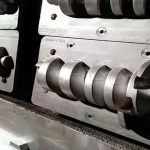Perform laser cladding tests on commonly used mold materials for product processing to study the relationship between the depth of the cladding layer and the process parameters, the change of microhardness in the cross section, the existence and distribution of alloy elements, and the changes in the wear resistance of the sample Trends, etc., to explore the feasibility of using laser cladding technology to improve mold performance and extend mold life.
- (1) Depth of cladding layer. With the increase of the laser power, the depth of the single-pass cladding layer increases faster, but after the power reaches 1.3kW, the depth increases less, basically reaching the limit depth. The curve fitting equation obtained by data regression processing is D=-0.0929P2+0.9091P+0.776, PÎ(700,1300), D is the depth of the cladding layer, mm; P is the laser power, W. When the overlap rate is 10% and multiple cladding is performed with different laser parameters, the cladding depth is 1.65~2.62mm, and the depth is the most uneven without laser preheating, and after adding WC to the cladding material, the cladding The unevenness of the cladding layer is more serious, that is, the unevenness of the depth of the cladding layer is aggravated.
- (2) Hardness of the cladding layer. Regardless of the alloy powder and laser process, the surface hardness is high after the cladding treatment, and the hardness of the subsurface layer is the highest, which can reach 945HV0.2; after adding 25% of the cladding alloy powder, the hardness does not increase significantly. After laser cladding, the structure of the cladding layer is uneven. The surface layer is a cast structure, while the subsurface layer and the bottom of the molten pool near the substrate are quenched structures, and the substrate still maintains the original tempered structure. Therefore, the hardness peak appears on the subsurface layer, not on the surface. The cladding layer mainly improves the hardness through solid solution strengthening, fine grain strengthening, and dispersion strengthening of the second phase.
- (3) Wear resistance. Under the same experimental conditions, the wear of the matrix sample is the largest, reaching 39.4g, while the wear resistance of the laser cladding surface is greatly improved, the absolute wear is only 9.3g, and the relative wear resistance can reach the highest cladding The former is 4.24 times, indicating that laser cladding can significantly improve the wear resistance of the surface. The wear resistance of the surface before and after the powder is added to the cladding alloy does not change significantly. There are many small planes on the wear surface of the cladding sample, as well as elongated scratches consistent with the sliding direction, indicating that the laser cladding surface has not only been subjected to adhesive wear, but also abrasive wear during the friction test. The measured amount of wear is the result of the combined effect of these two types of wear.
- (4) Organizational structure. Regardless of whether the alloy powder is added or not, the structure of the cladding layer is very similar. There are two types: near the bottom of the molten pool, a mixed structure of granular and short rods distributed on a nickel-chromium-silicon solid solution and a low-melting nickel-based eutectic matrix. It is a typical planar epitaxial growth structure; the other is a dendritic structure that grows roughly along the direction of heat flow in the middle and surface of the molten pool. The entire cladding layer structure is a mixed structure of planar crystals and dendrites. Under the scanning electron microscope, the eutectic structure of the cladding layer is more obvious, showing very neatly arranged fine dendrites. The addition of tungsten carbide did not change the structure, and the desired superhard spots of tungsten carbide were not observed. During the cladding cooling process, a part of tungsten forms a composite phase with chromium, boron, etc., and a small part is dissolved in the eutectic matrix. Spectroscopic analysis of the dendrite area and the dendrite shows that the dendrite area is a nickel-based solid solution and contains a certain amount of chromium, while the tungsten content is low, but the tungsten content between the dendrites is higher, indicating that tungsten carbide is at high temperatures. After being melted and cooled, tungsten carbide disappears and is distributed among the dendrites in the form of other second phases such as W3.2Cr1.8B3.
Mold Wiki provides you with the most comprehensive plastic, plastic, mold, mold design, decoration knowledge points of plastic mold brands, and shopping guide and online shopping services for various plastic molds, with the cheapest plastic mold prices and the best quality after-sales service. Please visit Mold Wiki: https://mold.wiki/Keywords of the article: mold design; products related to mold design:
Link to this article:Analyze the laser cladding structure and properties of die steel
Reprint Statement: If there are no special instructions, all articles on this site are original. Please indicate the source for reprinting:Mold Wiki,Thanks!^^

